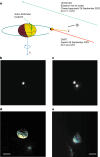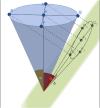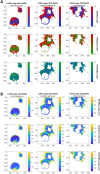The Dimorphos ejecta plume properties revealed by LICIACube
- PMID: 38418881
- PMCID: PMC10954540
- DOI: 10.1038/s41586-023-06998-2
The Dimorphos ejecta plume properties revealed by LICIACube
Abstract
The Double Asteroid Redirection Test (DART) had an impact with Dimorphos (a satellite of the asteroid Didymos) on 26 September 20221. Ground-based observations showed that the Didymos system brightened by a factor of 8.3 after the impact because of ejecta, returning to the pre-impact brightness 23.7 days afterwards2. Hubble Space Telescope observations made from 15 minutes after impact to 18.5 days after, with a spatial resolution of 2.1 kilometres per pixel, showed a complex evolution of the ejecta3, consistent with other asteroid impact events. The momentum enhancement factor, determined using the measured binary period change4, ranges between 2.2 and 4.9, depending on the assumptions about the mass and density of Dimorphos5. Here we report observations from the LUKE and LEIA instruments on the LICIACube cube satellite, which was deployed 15 days in advance of the impact of DART. Data were taken from 71 seconds before the impact until 320 seconds afterwards. The ejecta plume was a cone with an aperture angle of 140 ± 4 degrees. The inner region of the plume was blue, becoming redder with increasing distance from Dimorphos. The ejecta plume exhibited a complex and inhomogeneous structure, characterized by filaments, dust grains and single or clustered boulders. The ejecta velocities ranged from a few tens of metres per second to about 500 metres per second.
© 2024. The Author(s).
Conflict of interest statement
The authors declare no competing interests.
Figures












